Table of Contents
The WordPress ecosystem is always evolving. Page builders are fantastic, but the underlying hosting is just as crucial. Your hosting affects site speed, security, and scalability. Sometimes, the best alternative isn’t just another builder plugin. It might be a complete hosting platform designed for performance and ease of use. This article explores seven excellent hosting options to consider in 2025. These platforms provide strong foundations for any WordPress site, whether you use Elementor or another building approach. Let’s dive in.
Top Hosting Platforms to Consider in 2025
Choosing the right hosting is a big decision. It impacts everything from user experience to your bottom line. Oxygen Builder users often value control and performance. The good news? Many hosting providers offer exactly that, sometimes with tools that streamline workflows even more. We’ll look at ten platforms known for their quality, support, and WordPress expertise. We start with a solution tailored specifically for the Elementor ecosystem.
1. Elementor Hosting: An Integrated Elementor Experience
Elementor Hosting offers a seamless environment for building and managing Elementor websites. It’s designed to provide an optimized stack specifically for WordPress and Elementor. Think of it as a one-stop shop for launching your sites quickly and efficiently.
Features:
Elementor Hosting bundles managed WordPress hosting with the Elementor Core plugin pre-installed. This gets you started immediately with Elementor’s powerful drag-and-drop interface. Here’s a breakdown of key features:
- Managed WordPress Environment: Elementor handles the technical backend, including automatic updates for WordPress core, server-level caching, and performance tuning. Thus, you can focus more on design and content.
- Powered by Google Cloud Platform (GCP): The hosting runs on GCP’s premium tier network. This means access to cutting-edge infrastructure known for reliability, speed, and global reach. Your site benefits from Google’s robust network.
- Cloudflare Enterprise CDN: Content Delivery Network (CDN) integration is standard. Elementor uses Cloudflare’s premium CDN to cache your site’s content across numerous global locations. This dramatically speeds up load times for visitors worldwide and adds security layers.
- Robust Security: Security is a major focus. Features include free SSL certificates (auto-renewing), automatic daily backups (with easy restore), site monitoring, DDoS protection, and a web application firewall (WAF). They aim to keep your site safe from common threats.
- Staging Environment: Need to test changes safely? Most plans include a one-click staging environment. You can clone your live site, experiment with updates or new designs, and then push changes live confidently.
- Elementor Core Included: Every hosting plan comes with the free Elementor Core plugin pre-installed, so you can start building right away.
- Elementor Pro Integration: While Elementor Pro is purchased separately, the hosting is obviously built to work perfectly with it. If you need advanced widgets, theme building, form integrations, and marketing tools, adding an Elementor Pro license is straightforward. Elementor Hosting used to bundle Pro, but now includes Core, giving users flexibility in choosing their Pro plan.
- User-Friendly Dashboard: Your site is managed through a custom dashboard. It simplifies tasks like accessing backups, managing domains, and contacting support.
- Expert Support: Access to a dedicated support team is available 24/7. They are knowledgeable about both WordPress and Elementor, providing specialized help when you need it.
Pricing:
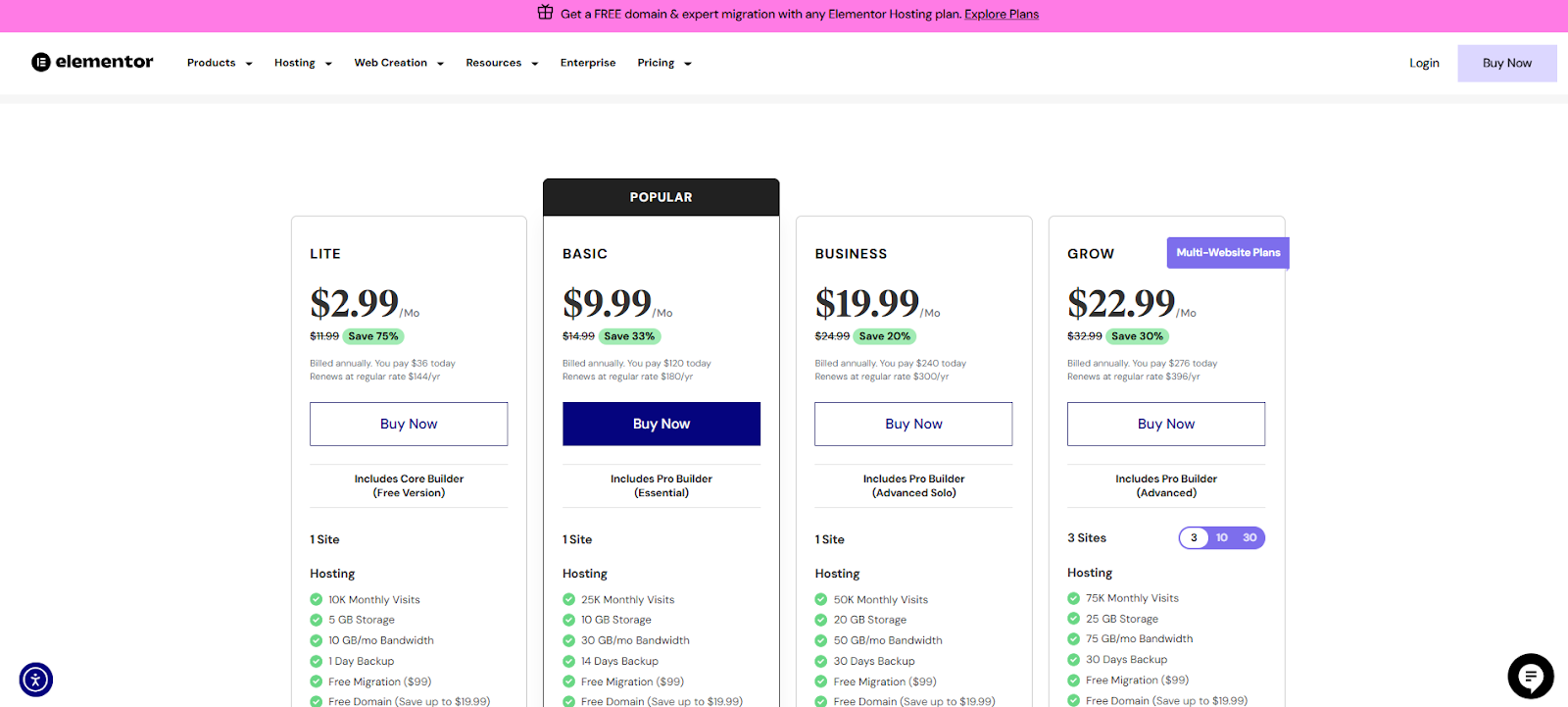
Elementor Hosting offers several tiered plans. Pricing generally starts low and increases based on resources like storage, bandwidth, and the number of websites allowed. As of early 2025, typical plans include:
- Basic/Lite: Aimed at single, simple websites. Offers essential storage and bandwidth.
- Business: More resources for growing sites, often includes staging.
- Grow: Supports multiple websites (e.g., 3 sites), increased storage, and visits.
- Scale: Designed for agencies or users managing numerous sites (e.g., 10 sites), offering substantial resources.
Note: Always check the official Elementor Hosting website for the most current pricing and plan details. Remember to factor in the separate cost of Elementor Pro if you need its features.
Who It’s Best For:
Elementor Hosting is an excellent choice for:
- Elementor Users: Anyone building websites with Elementor (Core or Pro) will find the optimized environment and integrated support highly beneficial.
- Freelancers and Agencies: The multi-site plans (Grow, Scale) and staging environments make it efficient for managing client projects built with Elementor.
- Beginners: The managed nature and simplified dashboard lower the technical barrier to entry for creating professional WordPress sites.
- Users Seeking Simplicity: If you want hosting and your primary builder from the same trusted source, this offers convenience and peace of mind.
Elementor Hosting provides a compelling package, especially if you’re committed to the Elementor ecosystem. It simplifies management and optimizes performance specifically for Elementor-built sites.
2. Kinsta: Premium Managed WordPress Hosting
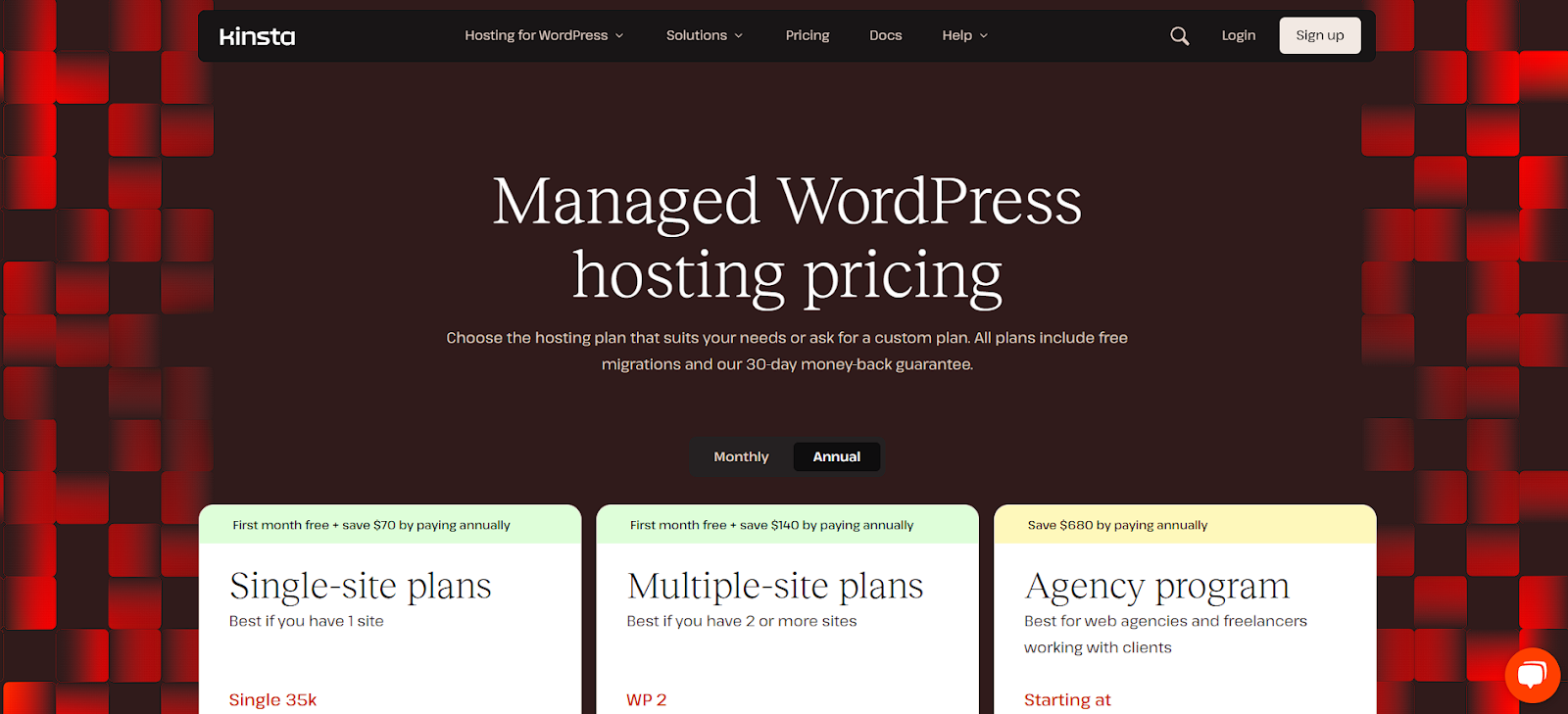
Kinsta is a well-respected name in the premium managed WordPress hosting space. It leverages the Google Cloud Platform’s premium tier network and focuses heavily on speed, security, and expert support. Kinsta aims to target users who need high performance and reliability.
Features:
Kinsta packs its plans with features designed for demanding WordPress sites:
- Google Cloud Platform Infrastructure: Like Elementor Hosting, Kinsta utilizes GCP’s top-tier network and C2 machines. This ensures fast loading times and high availability globally.
- NGINX, PHP 8.x, MariaDB: They use a modern software stack optimized for WordPress performance, including Nginx web servers, the latest PHP versions, and MariaDB databases.
- LXD Container Technology: Each WordPress site runs in its own isolated container. This enhances security and ensures resources aren’t shared directly with other sites on the server.
- Server-Level Caching: Kinsta implements multiple types of caching (bytecode, object, page, CDN) at the server level. This significantly reduces load times without needing extra caching plugins in many cases.
- Kinsta CDN (Powered by Cloudflare): All plans include a free high-performance CDN. It leverages Cloudflare’s extensive network to deliver content quickly worldwide.
- Top-Notch Security: Features include free SSL certificates (Let’s Encrypt), hardware firewalls, DDoS detection, proactive malware scanning, and automatic daily backups (with 14-30 day retention depending on the plan). They also offer free hack fixes if your site is compromised.
- Free Staging Environments: Every plan includes a one-click staging area. You can test updates, plugins, or code changes safely before deploying them to your live site.
- MyKinsta Dashboard: A custom-built dashboard provides a clean, intuitive interface for managing sites, monitoring performance, accessing backups, and collaborating with team members.
- Expert 24/7 Support: Kinsta is famous for its support team, which is composed of WordPress experts. Support is available via chat directly within the MyKinsta dashboard.
- Free Migrations: Kinsta offers free basic migrations. For many popular hosts (like WP Engine, SiteGround, Cloudways), they offer unlimited premium migrations handled by their team.
Pricing:
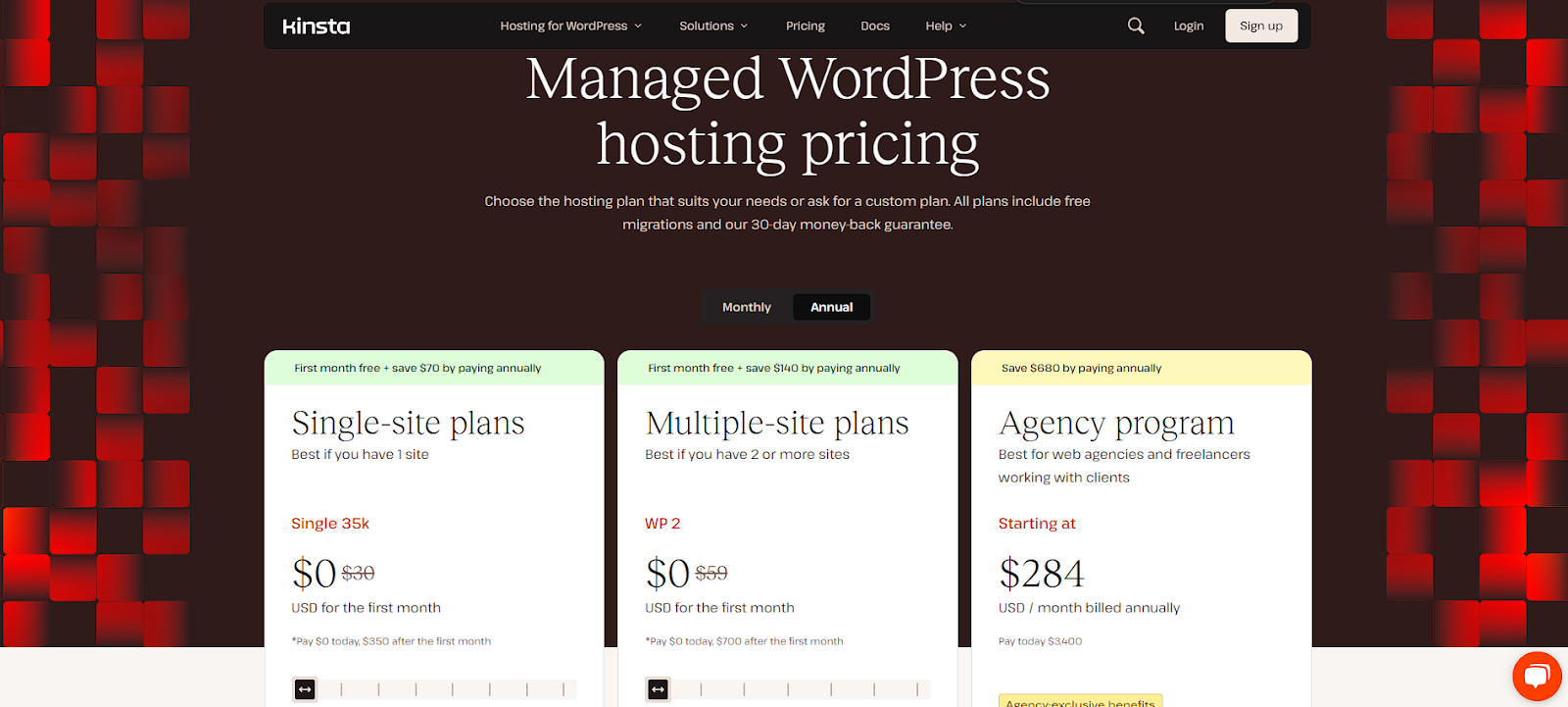
Kinsta offers Managed WordPress hosting plans with a free first month on selected options. Here’s a quick look at some of their offerings:
- Single-site plans: These are best for one site and start at $30/month. They include one WordPress install, 35,000 monthly visits, and 10GB storage.
- Multiple-site plans: Beginning at $59/month, these are ideal for two or more sites and include 2 WordPress installs, 70,000 monthly visits, and 20GB storage.
All plans include free migrations and a 30-day money-back guarantee.
Note: Kinsta’s visit counts are based on unique IP addresses per 24 hours. They clearly define how overages are handled. Check their site for current details.
Who It’s Best For:
Kinsta is ideal for:
- Businesses: Companies needing reliable, high-performance hosting with excellent support.
- High-Traffic Websites: Sites receiving significant visitor numbers benefit from Kinsta’s scalable infrastructure and caching.
- E-commerce Stores: Performance and security are critical for online stores; Kinsta delivers on both.
- Agencies and Developers: The robust platform, staging environments, and expert support are valuable for professionals managing client sites.
- Users Prioritizing Speed: If maximizing website speed is a top priority, Kinsta’s optimized stack and CDN are strong selling points.
Kinsta offers a powerful, albeit pricier, alternative. Its focus on performance, security, and expert support makes it a top contender for serious WordPress websites.
3. WP Engine: Enterprise-Grade WordPress Platform
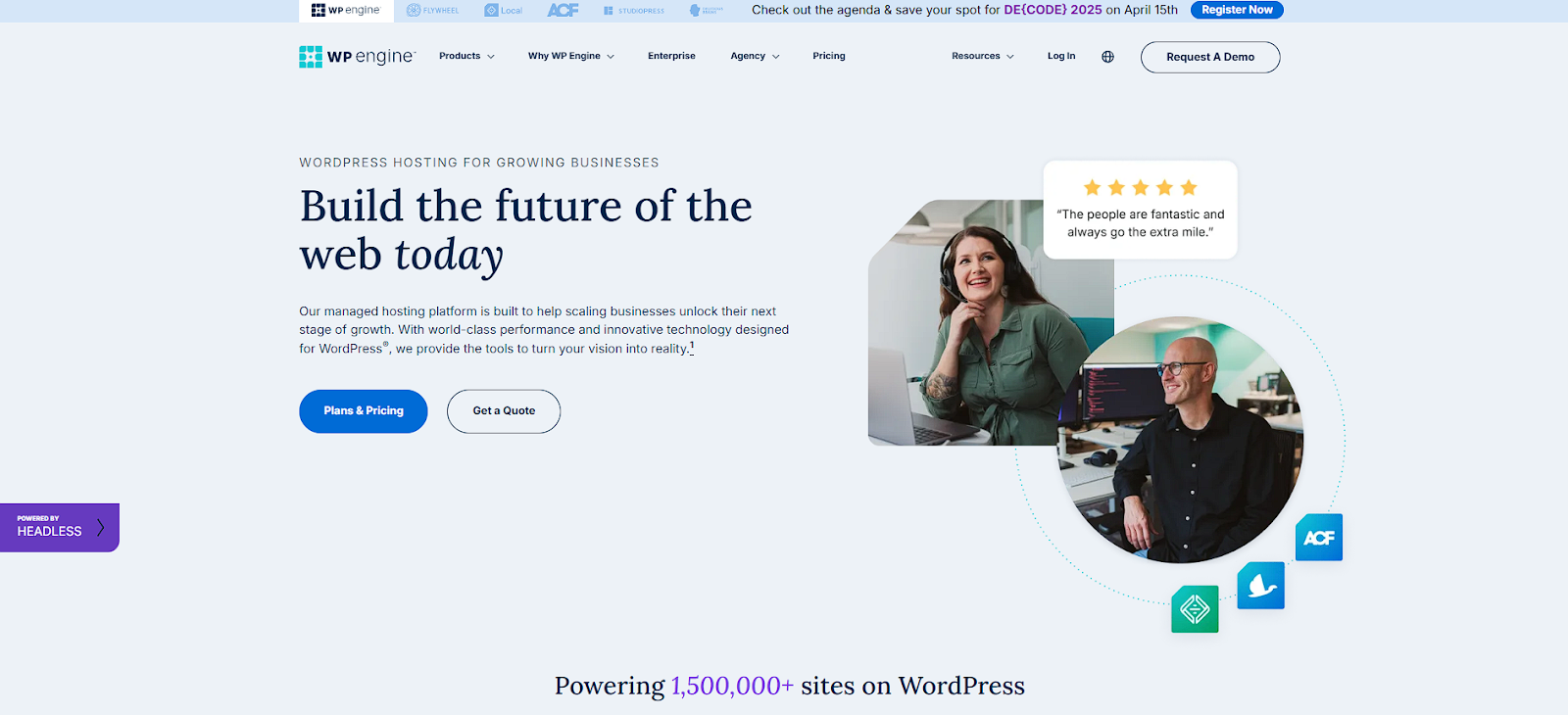
WP Engine is another giant in the managed WordPress hosting world. It caters heavily to developers, agencies, and larger businesses needing robust tools, scalability, and enterprise-level features. WP Engine acquired Flywheel (another host on this list) and often bundles the popular Genesis Framework and themes.
Features:
WP Engine provides a comprehensive platform built specifically for WordPress:
- Proprietary WordPress Platform: They run a finely tuned hosting architecture optimized for WordPress speed, security, and scalability.
- Google Cloud & AWS Infrastructure: WP Engine utilizes infrastructure from both Google Cloud Platform and Amazon Web Services, choosing the best options for performance and reliability.
- EverCache Technology: Their proprietary caching system (including page, object, and CDN caching) is designed to deliver WordPress content extremely fast.
- Global CDN: Integrated Content Delivery Network helps speed up global load times.
- Development Workflow Tools: WP Engine excels here. They offer Dev, Stage, and Prod environments for every site, allowing for a structured development, testing, and deployment process. Git integration and SSH access are also available.
- Automated WordPress & PHP Updates: They manage core WordPress and PHP updates, ensuring your site stays current and secure.
- Robust Security: Features include managed WAF, DDoS mitigation, automatic SSL certificates, daily backups, and proactive threat detection. They also offer free hack remediation.
- Genesis Framework & Themes: Many plans include access to the premium Genesis Framework and dozens of StudioPress themes, offering high-quality design foundations.
- 24/7 Expert Support: WP Engine provides award-winning support from WordPress specialists via chat and phone (phone support may depend on the plan).
- Performance Monitoring: Tools like Application Performance Monitoring (APM) are available (often as add-ons or on higher plans) to help diagnose performance bottlenecks.
Pricing:
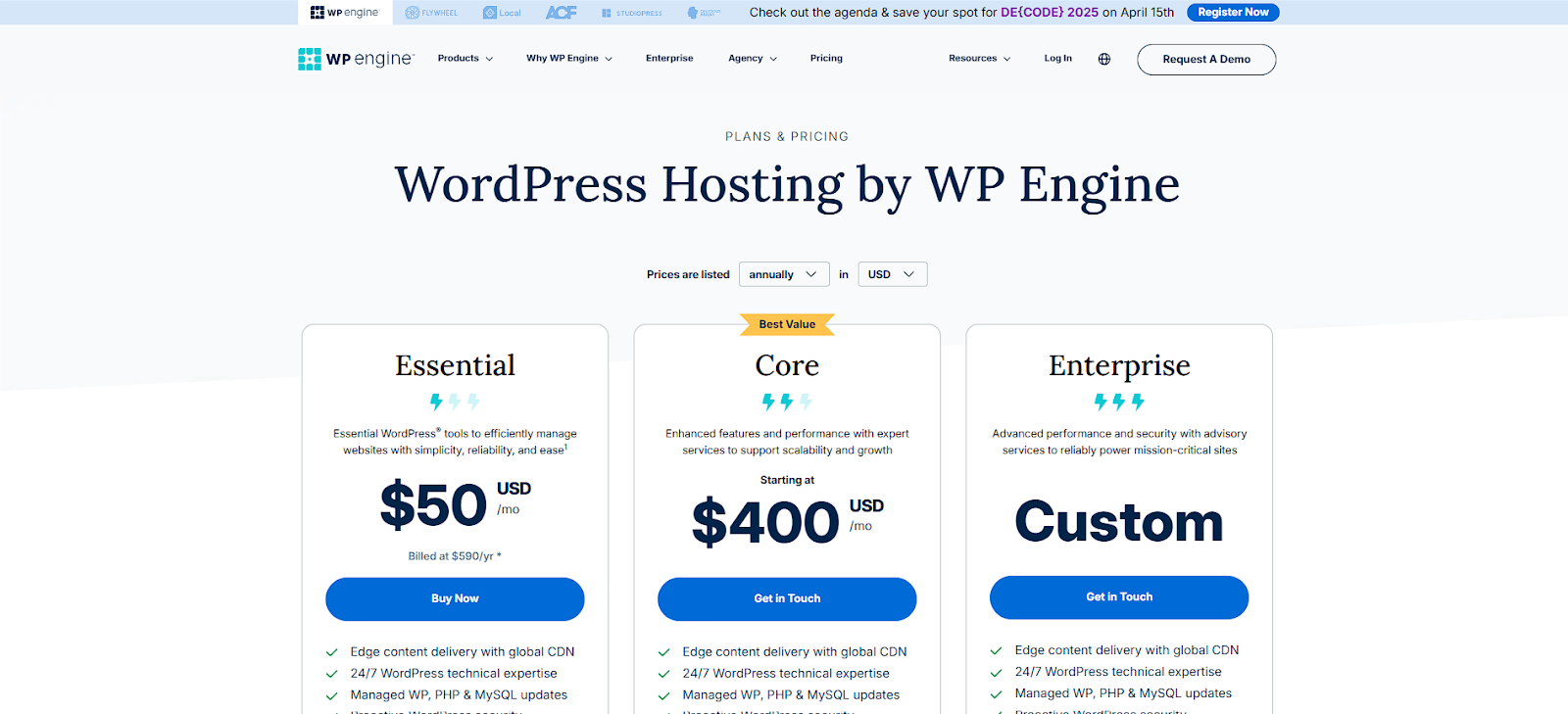
WP Engine offers managed WordPress hosting plans with a focus on performance and scalability.
- Essential: At $50/month (billed annually), this plan provides essential WordPress tools for efficient website management.
- Professional: Also starting at $50/month, this popular plan supports 3 sites, up to 75,000 monthly visits, and offers options to customize with additional features.
- Core: Beginning at $400/month, this plan provides enhanced performance and expert support for growing businesses.
- Enterprise: For mission-critical sites, this plan offers advanced performance, security, and custom pricing.
Note: WP Engine often runs promotions. Visit their site for current pricing and specific feature inclusions per plan.
Who It’s Best For:
WP Engine is a strong fit for:
- Developers and Agencies: The advanced workflow tools (Dev/Stage/Prod, Git, SSH) are highly valuable for professional development.
- Businesses Needing Scalability: The platform is built to handle growth and traffic spikes reliably.
- Enterprise Clients: Their custom solutions and robust infrastructure meet the demands of large organizations.
- Users Valuing Integrated Tools: Access to Genesis Framework/themes and performance monitoring tools adds significant value.
- Mission-Critical Websites: When uptime, security, and performance are paramount, WP Engine is a leading choice.
WP Engine provides an enterprise-grade managed WordPress experience with a strong emphasis on developer tools and scalability.
4. SiteGround: Feature-Rich Hosting with Great Value
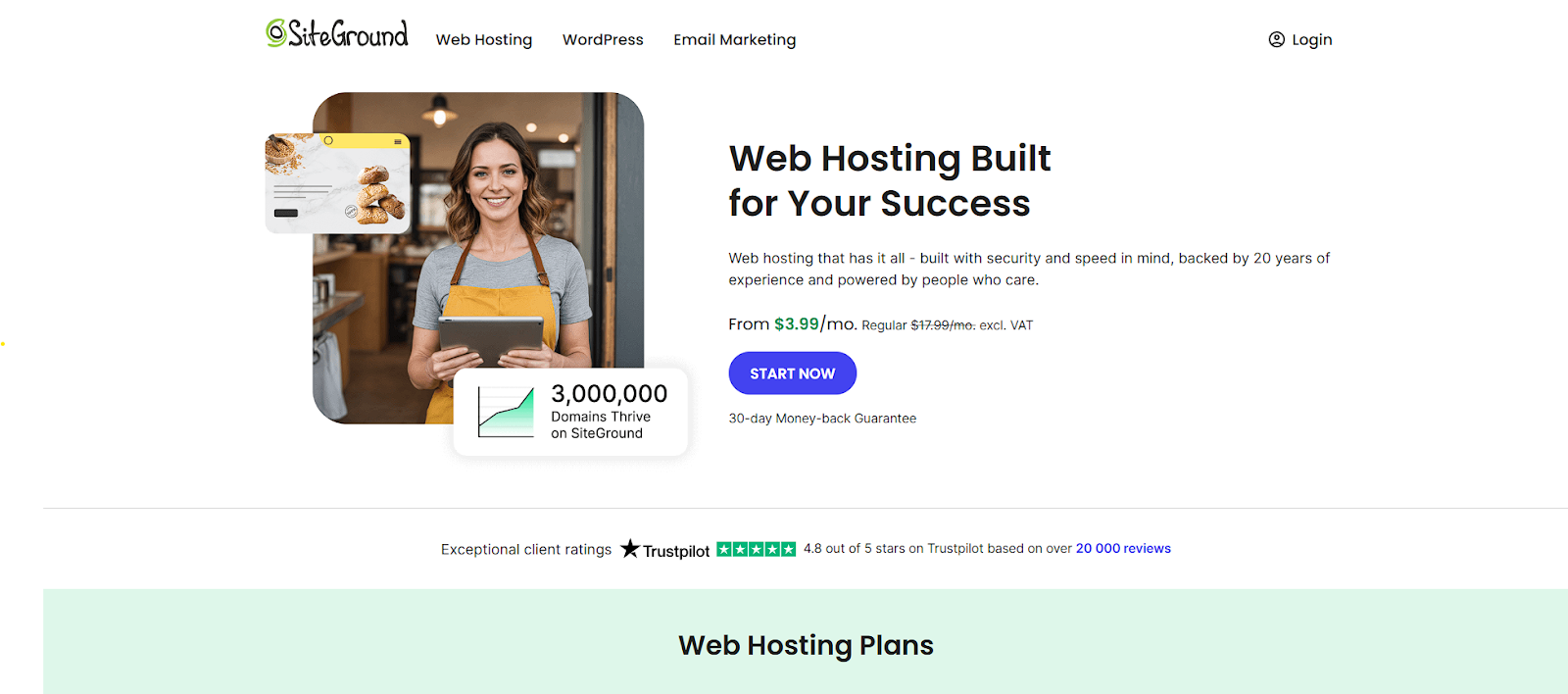
SiteGround is a popular hosting provider known for offering a good balance of features, performance, and affordability. They provide various hosting types, including shared, managed WordPress, WooCommerce, Cloud, and Reseller hosting. Their managed WordPress plans run on Google Cloud infrastructure.
Features:
SiteGround packs a lot into its plans, especially considering its price point:
- Google Cloud Platform: Their shared and WordPress hosting plans leverage GCP, ensuring good speed and reliability.
- Custom Control Panel (Site Tools): SiteGround moved away from cPanel to their own intuitive Site Tools dashboard. It makes managing websites, databases, email, and security features straightforward.
- NGINX Direct Delivery & SuperCacher: They use Nginx as a web server and have their own multi-layered caching system (static, dynamic, Memcached) called SuperCacher to optimize load times.
- Free CDN & SSL: All plans include Cloudflare CDN integration and free Let’s Encrypt SSL certificates.
- Managed WordPress Features: Automatic WordPress core and plugin updates, daily backups (with up to 30 copies stored), and a staging tool (on GrowBig and GoGeek plans) are standard.
- WordPress Starter Tool: An easy-onboarding wizard helps beginners quickly set up their WordPress site, including selecting themes and essential plugins.
- Collaboration Tools: Higher-tier plans allow adding collaborators to projects, which is useful for agencies or teams.
- Enhanced Security: They provide a custom WAF, an AI anti-bot system, regular security monitoring, and account isolation.
- Excellent 24/7 Support: SiteGround consistently receives praise for its fast, knowledgeable, and helpful customer support via chat, phone, and tickets.
Pricing:
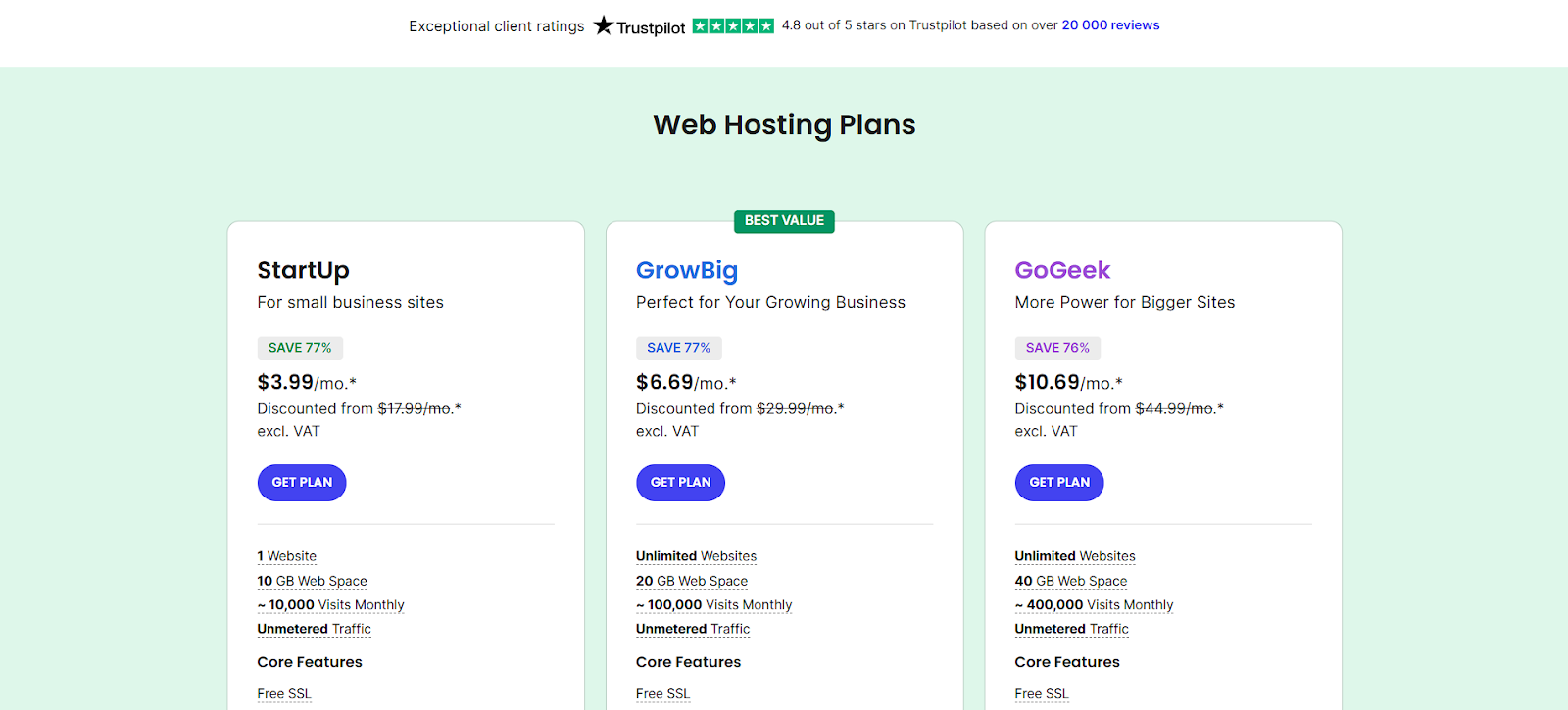
SiteGround offers three web hosting plans with pricing valid for the first 12 months (renewals cost more). All include unmetered traffic, a 30-day money-back guarantee, daily backups, free email, SSL, and CDN.
- StartUp ($3.99/mo): This plan includes one website, 10 GB of space, ~ and 10,000 visits/month. It’s great for small businesses.
- GrowBig ($6.69/mo): For unlimited sites, 20 GB space, ~100,000 visits/month. Adds on-demand backups, faster PHP, and staging tools.
- GoGeek ($10.69/mo): For unlimited sites, 40 GB space, ~400,000 visits/month. Includes Git staging, white-label options, and priority support.
Each plan includes SiteGround’s AI-powered Website Builder with professional templates.
Note: Prices are subject to change. Always check SiteGround’s website for current offers and renewal costs.
Who It’s Best For:
SiteGround is a great option for:
- Beginners and Small Businesses: The low entry price, ease of use (Site Tools), and helpful support make it very accessible.
- Users Seeking Value: It offers a strong feature set (GCP infrastructure, caching, staging, security) for its price range, especially the GrowBig plan.
- Multiple Website Owners: The GrowBig and GoGeek plans allow hosting unlimited websites.
- Those Who Appreciate Great Support: If responsive and effective customer service is important, SiteGround excels.
- WooCommerce Stores: They offer specialized WooCommerce plans with relevant features pre-installed.
SiteGround strikes a good balance, offering robust features and performance on reliable infrastructure with excellent support, making it a popular choice for many WordPress users. Just be mindful of the renewal pricing.
5. Cloudways: Flexible Managed Cloud Hosting
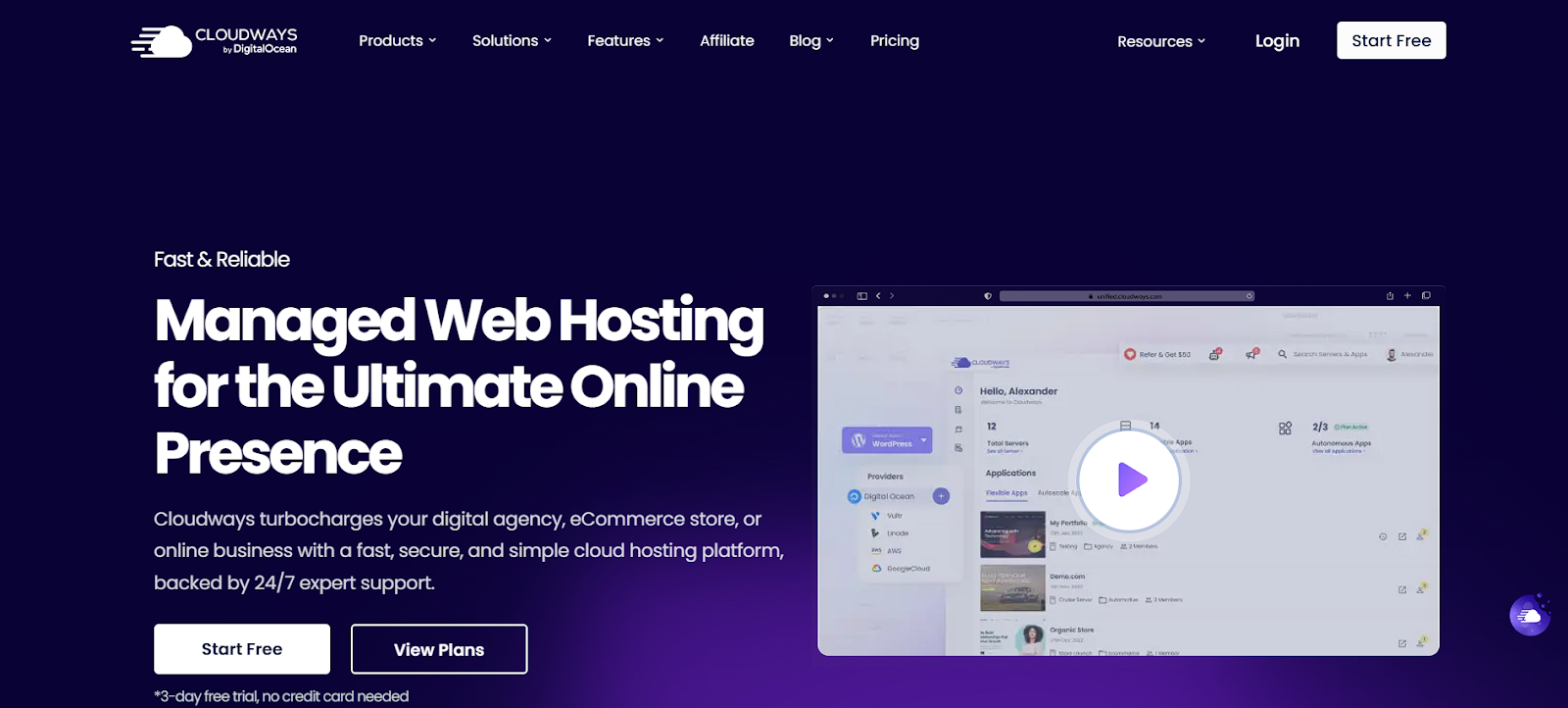
Cloudways offers a unique approach to managed hosting. Instead of owning data centers, they provide a platform to easily deploy and manage applications (like WordPress) on top cloud infrastructure providers. You choose the underlying cloud provider (DigitalOcean, Vultr, Linode, AWS, Google Cloud) that best suits your needs and budget.
Features:
Cloudways acts as a management layer, simplifying cloud hosting:
- Choice of Cloud Providers: Select from five leading IaaS providers. This gives you flexibility in server location, performance characteristics, and pricing.
- Managed Platform: Cloudways handles server setup, security patching, OS updates, and provides 24/7 monitoring and support.
- Optimized Stack (ThunderStack): Their hosting stack includes Nginx, Apache, Memcached, Varnish, Redis, and the latest PHP versions, configured for performance.
- Cloudways Cache: Includes built-in caching options like Varnish and Redis object cache for improved speed.
- CloudwaysCDN: An optional, pay-as-you-go CDN add-on (powered by StackPath/Cloudflare) is available for global content delivery.
- Free SSL Certificates: Easy installation of Let’s Encrypt SSL certificates.
- Automated & On-Demand Backups: Configure automated backup frequency and perform manual backups easily. Offsite backup storage is available.
- Staging Environments: One-click staging areas are available for all applications.
- Vertical Scaling: Easily scale server resources (RAM, CPU, storage) up or down as needed without changing your IP address.
- Team Collaboration Features: Add team members with specific access roles.
- Bot Protection: Integrated security features to block malicious bots and login attempts.
- 24/7 Expert Support: Support is available via live chat and ticketing. Premium support add-ons offer faster response times and deeper assistance.
Pricing:
Cloudways offers flexible pricing for managed cloud hosting, and here’s a summary of their DigitalOcean (Premium) plans:
- DO1GB: $14/month for 1 GB RAM, 1 Core processor, 25 GB storage, and 1 TB bandwidth.
- DO2GB: $28/month for 2 GB RAM, 1-core processor, 50 GB storage, and 2 TB bandwidth.
- DO4GB: $54/month for 4 GB RAM, 2-core processor, 80 GB storage, and 4 TB bandwidth.
- DO8GB: $99/month for 8 GB RAM, 4-core processor, 160 GB storage, and 5 TB bandwidth.
Cloudways also provides a free trial, 24/7 support, a built-in firewall, free SSL certificates, and free object cache pro.
Note: Pricing varies based on the chosen provider, server specs, and data center location. Cloudways offers a free trial. Check their site for detailed, up-to-date pricing.
Who It’s Best For:
Cloudways is an excellent choice for:
- Developers and Agencies: The flexibility, control, scaling options, and choice of providers are highly appealing.
- Users Needing Specific Server Locations: With multiple providers and data centers worldwide, you can host closer to your target audience.
- Performance-Oriented Users: Access to powerful cloud infrastructure allows for high performance.
- Those Who Prefer Pay-As-You-Go: The pricing model can be cost-effective, especially if resource needs fluctuate.
- Users Comfortable with a Slightly More Technical Interface: While managed, it offers more server-level access than some other managed hosts.
Cloudways provides a unique and powerful hosting solution by bridging the gap between complex IaaS and traditional managed hosting, offering great flexibility and performance.
6. Flywheel: Managed Hosting Designed for Creatives
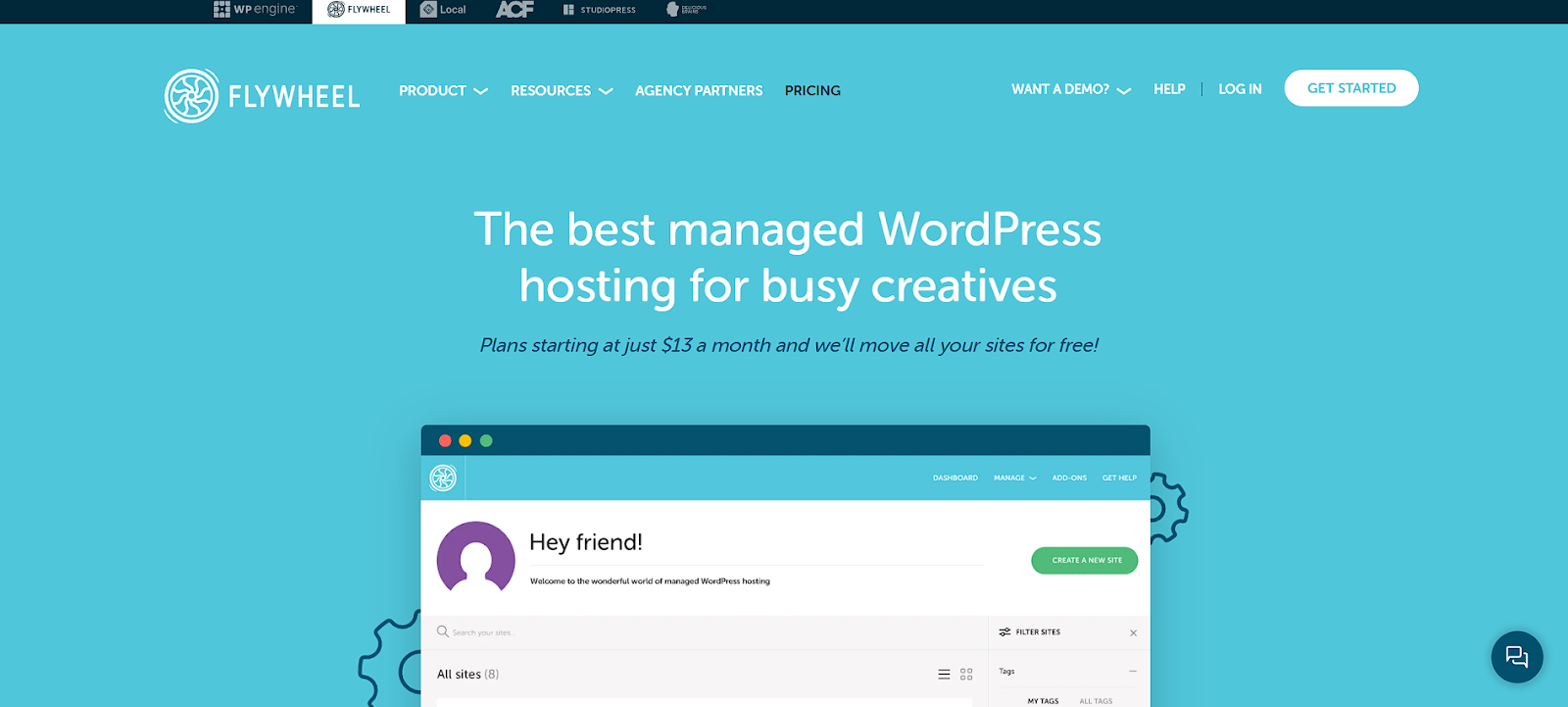
Flywheel, now owned by WP Engine, specifically targets web designers, developers, and creative agencies. Their platform focuses on streamlining workflows and collaboration and providing a beautiful, user-friendly interface for managing WordPress sites.
Features:
Flywheel emphasizes ease of use and tools tailored for creatives:
- Managed WordPress Hosting: Optimized stack built on Google Cloud Platform infrastructure.
- Intuitive Dashboard: A clean, visually appealing dashboard makes managing sites, billing, and collaboration simple.
- Fast Performance: Includes server-level caching (FlyCache) and integrates with a global CDN for speed.
- Workflow Tools:
- Blueprints: Save WordPress configurations (themes, plugins, settings) as reusable templates to launch new sites quickly.
- Staging Sites: Easy-to-use staging environments for testing changes.
- Organizations: Manage multiple team members and client sites under one umbrella.
- Billing Transfer: Easily transfer site ownership and bill clients directly.
- Nightly Backups: Automatic backups are performed every night, with easy one-click restores.
- Solid Security: Free SSL certificates, managed WordPress updates, malware monitoring, and free hack cleanup.
- Collaboration Focus: Designed for teams, allowing easy addition of collaborators with specific permissions.
- Expert Support: 24/7 support from WordPress experts via chat, email, and phone (depending on plan).
Pricing:
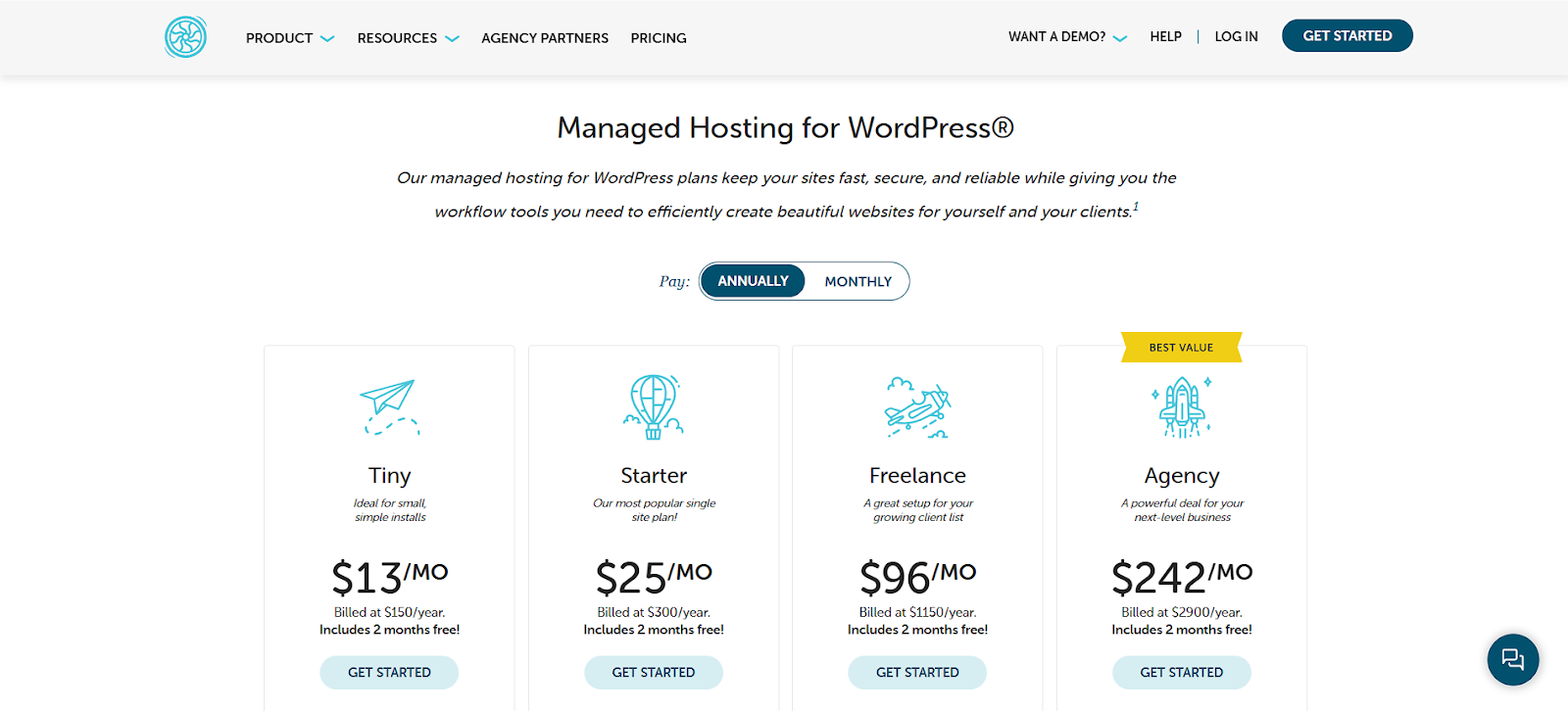
Flywheel offers several hosting plans with both monthly and annual payment options. Here’s a quick overview:
- Tiny: $13/month ($150/year) – 1 site, 5,000 monthly visits, 5GB storage.
- Starter: $25/month ($300/year) – 1 site, 25,000 monthly visits, 10GB storage.
- Freelance: $96/month ($1150/year) – Up to 10 sites, 100,000 monthly visits, 20GB storage.
- Agency: $242/month ($2900/year) – Up to 30 sites, 400,000 monthly visits, 50GB storage.
Custom plans are also available for those with larger hosting requirements.
Note: Annual payments usually offer a discount. Check Flywheel’s website for the latest plan structures and pricing.
Who It’s Best For:
Flywheel is particularly well-suited for:
- Web Designers and Developers: The workflow tools (Blueprints, Staging, Collaboration) are built for their specific needs.
- Creative Agencies: The platform simplifies managing numerous client sites and team collaboration.
- Freelancers: The Freelance plan offers a good balance for managing a portfolio of client projects.
- Users Who Value Aesthetics and UX: Flywheel’s dashboard and overall user experience are highly regarded.
- Those Needing Simple Client Handoff: The billing transfer feature streamlines the process of handing sites over to clients.
Flywheel provides a polished, managed WordPress hosting experience with unique tools designed to make life easier for web creators and agencies.
7. Bluehost: Accessible Hosting Recommended by WordPress.org
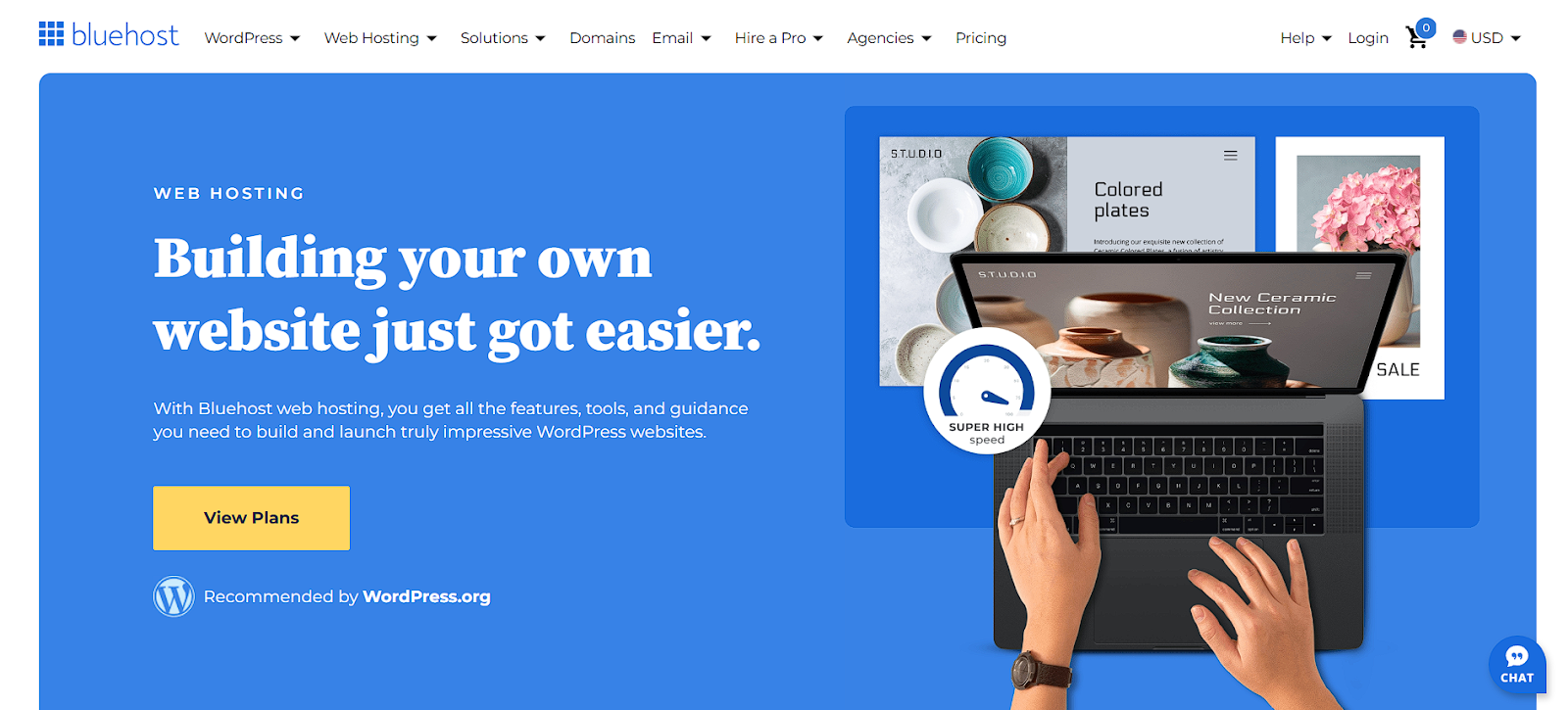
Bluehost is one of the most well-known names in web hosting, partly due to WordPress.org’s long-standing recommendation. They offer a wide range of hosting services, including shared, VPS, dedicated, and specialized Managed WordPress plans. They often focus on affordability and ease of use, especially for beginners.
Features:
Bluehost’s Managed WordPress plans offer more than their basic shared options:
- Managed Environment: Handles core WordPress updates, security patches, and server maintenance.
- Enhanced Performance: Often includes multi-layer caching, SSD storage (though NVMe might be on higher tiers or specific plans), and integrated CDN (Cloudflare).
- Bluehost WonderSuite (AI Site Builder): Newer plans incorporate AI tools to help users create website content and layouts quickly within WordPress.
- Security Features: Free SSL certificates, daily website backups (often on higher plans like Choice Plus/Pro), malware scanning (sometimes as an add-on like SiteLock).
- Staging Environment: Managed plans typically include a staging area to test changes.
- User-Friendly Dashboard: A custom dashboard simplifies WordPress management, domain connections, and accessing support.
- Domain Name: Often includes a free domain name for the first year.
- Marketing Tools: Integration with Google My Business and some marketing credits might be included.
- 24/7 Support: Offers support via phone and chat.
Pricing:
Bluehost provides four web hosting plans for a 12-month term with varying features. Here’s a quick look:
- BASIC: Starting at $2.95/month, this plan supports one website with essential features.
- PLUS: For $4.95/month, you can host multiple websites with more storage and visits.
- CHOICE PLUS: This recommended plan, priced at $5.45/month, supports more websites and includes added privacy and security.
- PRO: At $13.95/month, this plan offers the most resources for multiple websites with enhanced performance.
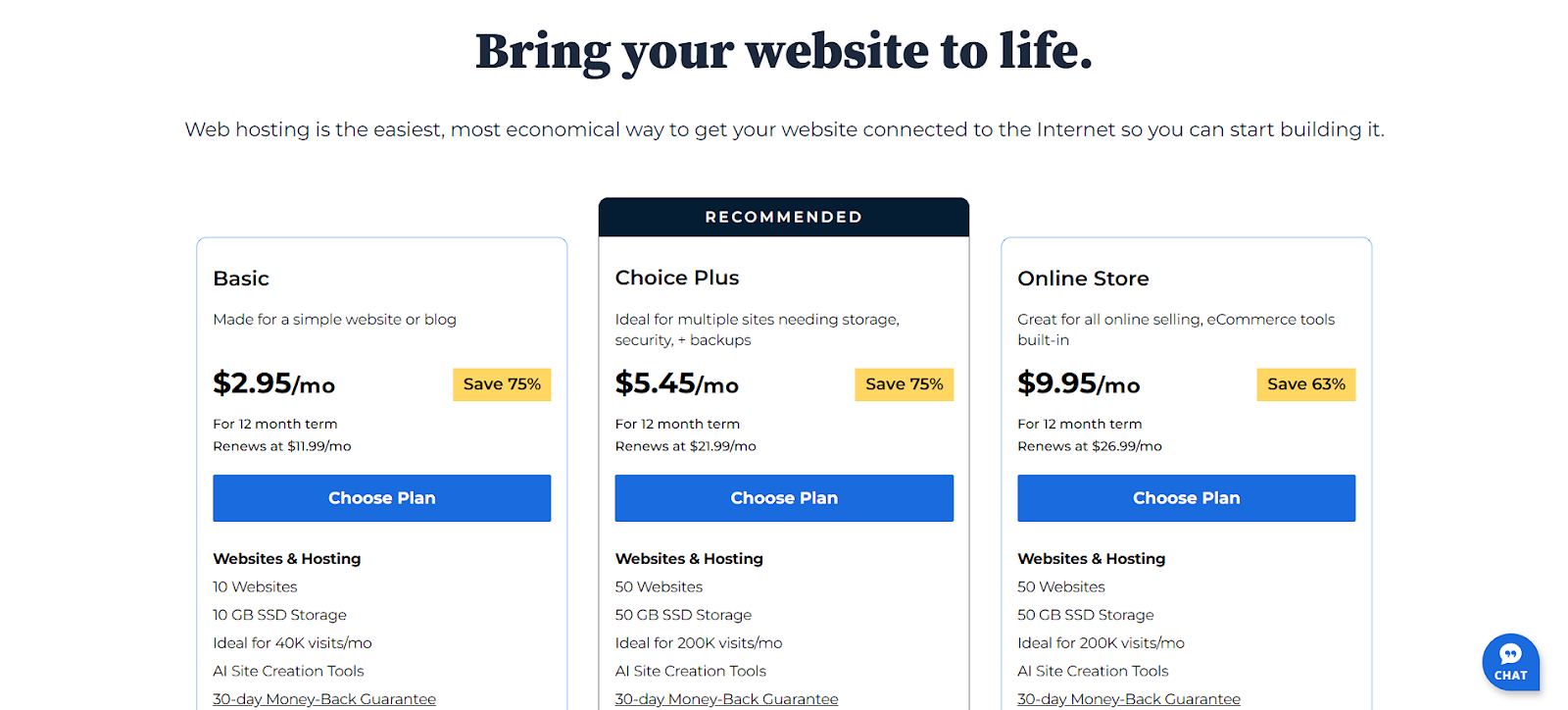
Note: Carefully review the features included in Managed WordPress plans versus standard shared plans. Pay close attention to renewal rates. Check Bluehost’s site for current offerings.
Who It’s Best For:
Bluehost, particularly its Managed WordPress options, can be suitable for:
- Beginners: The user-friendly interface, WordPress focus, and AI tools lower the barrier to entry.
- Small Businesses on a Budget: Initial pricing can be very attractive, though long-term costs need consideration.
- Simple WordPress Websites/Blogs: For sites without complex technical requirements, it provides a straightforward solution.
- Users Who Want a Free Domain: The included domain for the first year is a common perk.
Bluehost offers an accessible entry point into WordPress hosting, backed by a major brand name and a WordPress.org recommendation. Ensure you choose a plan (likely a managed one) that fits your performance and feature needs, and be aware of renewal costs.
Selecting Your Ideal Hosting Partner
Choosing from these excellent options can feel overwhelming. How do you pick the right one for your specific situation? It comes down to understanding your needs and priorities. Let’s break down the key factors to consider.
Why WordPress & WooCommerce Optimization Matters
Not all hosting is created equal, especially for dynamic platforms like WordPress and WooCommerce. Generic hosting might work, but optimized hosting makes a huge difference.
Optimized providers tune their servers (software like Nginx, PHP, databases like MariaDB) specifically for WordPress. They implement caching layers (page, object, database) that drastically speed up how quickly your site serves content. This is even more critical for WooCommerce.
Online stores have many dynamic elements (carts, user accounts, checkout) that bypass standard caching. Optimized WooCommerce hosting accounts for this, ensuring smooth performance even during busy sales periods. Choosing a host specializing in WordPress/WooCommerce means better speed, stability, and scalability.
Matching Hosting to Your Website’s Demands
Think honestly about your website. Is it a simple brochure site or blog with mostly static content? Or is it a complex web application, membership site, or busy online store? Consider these points:
- Traffic Volume: How many visitors do you expect now? How many in the future? Hosts specify visit limits or bandwidth allowances. Choose a plan that comfortably handles your current traffic with room to grow. High-traffic sites need robust infrastructure (like Kinsta, WP Engine, Nexcess, Rocket.net).
- Site Complexity: A simple blog needs fewer resources than a WooCommerce store with thousands of products or a site running many heavy plugins. Complex sites require more RAM, CPU power, and efficient database handling.
- Resource Usage: Are you hosting large media files (videos, high-res images)? Do your plugins consume a lot of server resources? Check the storage (SSD or NVMe) and RAM provided with the plan. NVMe storage offers a significant speed boost over traditional SSDs.
Planning for Scalability and Growth
Your website might start small, but it will grow! Your hosting needs could change dramatically over time. Consider how easily you can scale with a provider:
- Vertical Scaling: Can you easily increase resources like RAM, CPU, or storage on your current plan/server? Cloud providers like Cloudways excel here. Managed hosts like Kinsta or WP Engine often require upgrading to a higher plan tier.
- Horizontal Scaling: Does the host offer solutions for very large sites, such as load balancing across multiple servers? This is typically an enterprise-level feature.
- Ease of Upgrade: How simple is the process of moving to a higher plan? Is there downtime involved? Most managed hosts make this fairly seamless.
Choose a host that offers clear upgrade paths that align with your potential growth trajectory.
Balancing Budget and Performance
Price is always a factor, but it shouldn’t be the only factor. The cheapest hosting might cost you more in the long run through lost visitors, poor SEO rankings, or security breaches. Think about value, not just the sticker price:
- Total Cost of Ownership (TCO): Consider introductory prices and renewal rates. Factor in the cost of essential features that might be add-ons elsewhere (like SSL, CDN, backups, staging).
- Performance Impact: Faster hosting improves user experience and SEO, potentially leading to higher conversions and revenue. Sometimes, paying more for premium hosting (Kinsta, WP Engine, Nexcess, Rocket.net) yields a positive return on investment.
- Time Savings: Managed hosting saves you time on server maintenance, updates, and security. Factor in the value of your time.
Find the sweet spot that provides the performance and features you need within a budget you can sustain long-term.
The Non-Negotiables: Reliability and Uptime
Your website needs to be accessible. Downtime means lost visitors, lost revenue, and damage to your reputation. Look for hosts with a strong uptime record:
- Uptime Guarantee (SLA): Many reputable hosts offer a Service Level Agreement (SLA) guaranteeing a certain percentage of uptime (often 99.9% or higher). Check the terms – what compensation do they offer if they fail to meet it?
- Infrastructure Redundancy: Does the host use reliable infrastructure (like Google Cloud, AWS)? Do they have redundant systems to prevent single points of failure?
- Monitoring: Good hosts monitor their servers 24/7 to address issues proactively before they cause significant downtime.
Don’t compromise on reliability. Choose a host known for stable performance.
Speed Advantage: The Role of NVMe Storage
You’ll often see hosting plans mention SSD storage. That’s much faster than old Hard Disk Drives (HDDs). However, the next step is NVMe (Non-Volatile Memory Express) SSD storage. NVMe is a newer protocol designed specifically for SSDs, allowing them to communicate much faster with the rest of the server system (via the PCIe bus, rather than the older SATA interface).
What does this mean for your website? Faster data access. Databases query faster, files load quicker, and overall site responsiveness improves. Many premium hosts (like Kinsta, Rocket.net, some Cloudways configurations) now offer NVMe storage because it provides a noticeable performance boost, especially for database-heavy sites like WooCommerce or large membership sites. If speed is critical, look for plans featuring NVMe SSDs.
Accessing Expert Help When You Need It (24/7 Support)
Even with the best hosting, things can sometimes go wrong, or you might just have questions. Responsive, knowledgeable support is invaluable.
- Availability: Is support available 24/7? What channels do they offer (live chat, phone, email, tickets)?
- Expertise: Are the support agents knowledgeable about WordPress specifically? Premium managed hosts (Kinsta, WP Engine, Nexcess, Flywheel, Elementor Hosting) typically employ WordPress experts.
- Response Time: How quickly can you expect a response, especially for urgent issues? Check reviews and SLAs if available.
Don’t underestimate the value of good support. It can save you hours of frustration when you encounter a problem.
Streamlined Management: The User Interface Factor
You’ll interact with your hosting control panel regularly to manage sites, domains, backups, emails, and databases. A clean, intuitive interface makes these tasks much easier.
- Control Panel Type: Is it standard cPanel/Plesk, or a custom dashboard (like Elementor Hosting’s, Kinsta’s MyKinsta, SiteGround’s Site Tools, Flywheel’s dashboard)? Custom dashboards are often more user-friendly but might lack some obscure features found in cPanel.
- Ease of Use: Is the interface logically organized? Can you find common tasks easily?
- Essential Features: Does the dashboard provide easy access to backups, restores, staging sites, domain management, SSL installation, and performance settings?
A well-designed user interface contributes significantly to a positive hosting experience. Consider trying a free trial or looking at dashboard screenshots/demos.
Smooth Sailing: Navigating Your Hosting Migration
Moving your website from one host to another can seem daunting, but with careful planning, it can be a smooth process. Here’s what to consider when migrating to one of these hosting alternatives.
Your Website’s Journey: The Data Transfer
Getting your website files and database from the old host to the new one is the core of the migration. You have several options:
- Provider Assistance: Many managed hosts (Kinsta, WP Engine, Nexcess, Rocket.net, Flywheel, SiteGround, Elementor Hosting) offer free or paid migration services. Their experts handle the entire transfer, which is often the easiest and safest option. Check the terms – some offer unlimited free migrations from specific hosts.
- Migration Plugins: WordPress plugins like Duplicator, Migrate Guru, WP Migrate DB Pro, or All-in-One WP Migration can automate the process. Migrate Guru is often recommended as it processes the migration on its own servers, reducing your site’s load. Follow the plugin instructions carefully.
- Manual Migration: This involves manually downloading your website files (via FTP/SFTP or file manager) and exporting your database (via phpMyAdmin). You then upload the files and import the database on the new host. This requires technical confidence and careful execution, including updating configuration files (like wp-config.php).
Choose the method you’re most comfortable with or leverage the expertise of your new host. Always back up your site before starting any migration.
Pointing the Way: Managing Your Domain Name
Once your site files and database are on the new host and tested (often via a temporary URL or hosts file modification), you need to point your domain name to the new server.
- DNS Updates: This involves changing the Domain Name System (DNS) records for your domain, specifically the A records (pointing to the server’s IP address) or Nameservers (delegating DNS control to the new host). Your new hosting provider will give you the necessary IP address or nameserver details.
- Accessing DNS Settings: You’ll typically update DNS records where your domain is registered (e.g., GoDaddy, Namecheap) or where your DNS is currently managed (which might be your old host or a service like Cloudflare).
- Propagation Time: After updating DNS records, it can take anywhere from a few minutes to 48 hours for the changes to fully propagate across the internet. During this time, some visitors might still see the old site while others see the new one.
Plan your DNS change carefully, often during a low-traffic period.
Keeping Connected: Email Hosting Considerations
How is your email currently handled? Don’t forget about it during migration!
- Hosting Included Email: If your old host provided email accounts (e.g., [email protected]), you need a plan for email on the new host. Some hosts (like SiteGround, Bluehost via cPanel) offer integrated email hosting. Others (like Kinsta, WP Engine, Elementor Hosting, Flywheel, Rocket.net) do not host email directly and recommend using dedicated email providers.
- Third-Party Email Providers: Services like Google Workspace or Microsoft 365 offer robust, professional email hosting separate from your website hosting. This is often the recommended approach for reliability and features.
- MX Records: If you move your website hosting but keep your email hosted elsewhere (or switch to a third-party provider), you’ll need to ensure your domain’s MX (Mail Exchanger) records in your DNS settings correctly point to your email provider’s servers. Migrating nameservers to the new web host might require you to re-configure these MX records in the new host’s DNS zone editor.
Confirm your email hosting strategy before migrating your website and updating DNS.
Zero Interruption: Strategies for Seamless Migration
The goal is to minimize or eliminate downtime – the period when your site is inaccessible.
- Test Thoroughly: Use the new host’s staging environment or temporary URL to fully test the migrated site before changing DNS. Check links, forms, images, and functionality.
- Reduce DNS Propagation Effects: Lower the TTL (Time To Live) value on your current DNS records a day or two before the switch. This tells networks to check for updates more frequently, potentially speeding up propagation. (Change it back after migration).
- Timing: Perform the final DNS switch during your website’s lowest traffic period (e.g., late night or weekend, depending on your audience).
- Keep Old Hosting Active: Don’t cancel your old hosting immediately after switching DNS. Keep it active for a few days as a fallback until you’re certain the migration is complete and stable.
Careful planning and testing are key to avoiding downtime.
Effortless Moves: Leveraging One-Click Migration Tools
Many hosts understand migration can be a pain point. They often provide tools or services to simplify it:
- Managed Migration Services: As mentioned, many hosts offer free (or paid premium) migrations handled entirely by their team. This is often the most stress-free option. Check eligibility and how to request it.
- Proprietary Migration Plugins: Some hosts (like SiteGround) offer their own dedicated WordPress migration plugin designed to work seamlessly with their platform.
- Integration with Popular Plugins: Hosts often provide clear guides on using popular migration plugins like Migrate Guru or Duplicator with their environment.
Check your new host’s documentation or support resources for their recommended migration methods and tools. Taking advantage of these can save significant time and effort.
Unleashing Performance on Your New Platform
You’ve successfully migrated! Now it’s time to ensure your website runs as fast and efficiently as possible on its new hosting environment. Even with great hosting, optimizing your site itself is crucial.
Fine-Tuning for Speed: Essential Performance Tips
Beyond server-level optimizations provided by your host, focus on these website-level tweaks:
- Image Optimization: Large images are a major speed killer. Use tools or plugins (like Smush, ShortPixel, Imagify) to compress images without sacrificing visual quality. If possible, serve images in modern formats like WebP. Ensure images are correctly sized for their containers—don’t upload huge images just to shrink them with CSS.
- Code Minification: Minify your CSS, JavaScript, and HTML files. This removes unnecessary characters (whitespace, comments) from the code, making files smaller and faster to download and parse. Many caching plugins (like WP Rocket, W3 Total Cache) or performance suites offer this feature. Your host might also provide options via their control panel or CDN.
- Database Optimization: Over time, your WordPress database accumulates overhead (transients, post revisions, spam comments, etc.). Use plugins like WP-Optimize or Advanced Database Cleaner to clean and optimize your database tables regularly. A leaner database responds faster.
- Limit External Scripts: Third-party scripts (for analytics, ads, social media feeds, tracking pixels) can significantly slow down your site. Audit your external scripts, remove any you don’t absolutely need, and defer loading non-critical scripts where possible.
- Choose a Lightweight Theme: A well-coded, lightweight theme provides a faster foundation. Bloated themes with excessive features can drag down performance. Frameworks like GeneratePress, Astra, Kadence, or Elementor’s Hello Theme are known for being performance-focused.
- Update Everything: Keep WordPress core, themes, and plugins updated. Updates often include performance improvements and security patches. If your site is compatible, use PHP 8.x; it offers significant speed gains over older versions.
Speed Boosters: Caching and Content Delivery Networks (CDNs)
Caching and CDNs are fundamental to website speed:
- Caching: This involves storing copies of your site’s files or data closer to the user or in faster memory, reducing the work the server needs to do for each request.
- Page Caching saves static HTML versions of your pages. It is essential for most sites. Your host likely provides server-level page caching (Varnish, Nginx FastCGI cache). Use a plugin like WP Rocket. Ensure that only the one-page caching method is active to avoid conflicts.
- Object Caching: Stores results of complex database queries in memory (using Redis or Memcached). Very beneficial for dynamic sites, WooCommerce, and membership sites. Many managed hosts offer easy enablement of object caching.
- Browser Caching: Instructs visitors’ browsers to store static assets (images, CSS, JS) locally. Subsequent visits load much faster. Configured via server rules or caching plugins.
- Content Delivery Network (CDN): A CDN is a network of servers distributed globally. It stores copies of your static assets (images, CSS, JS) on these servers. When a visitor accesses your site, the CDN delivers these assets from the server geographically closest to them, dramatically reducing latency and speeding up load times, especially for international audiences. Most quality hosts (Elementor Hosting, Kinsta, SiteGround, WP Engine, Nexcess, Rocket.net) include a CDN, often powered by Cloudflare or their own network. Ensure it’s activated and configured correctly.
Leveraging both effective caching and a CDN is non-negotiable for optimal performance.
The Power of the Cloud: Infrastructure Advantages
Many top hosting providers (Elementor Hosting, Kinsta, SiteGround, WP Engine, Cloudways, Flywheel) utilize cloud infrastructure like Google Cloud Platform (GCP) or Amazon Web Services (AWS). This offers significant advantages over traditional single-server hosting:
- Scalability: Cloud platforms are designed for elasticity. Compared to dedicated hardware, resources can often be scaled up (or down) more easily to handle traffic fluctuations or growth.
- Reliability: Cloud providers have massive redundancy built into their networks and data centers. Hardware failures are less likely to cause significant downtime as traffic can be rerouted.
- Geographic Distribution: Major cloud providers have data centers worldwide. Hosting on the cloud allows you to choose server locations closer to your primary audience, reducing latency. CDNs further enhance this global reach.
- Performance: Cloud providers invest heavily in cutting-edge hardware (fast CPUs, NVMe storage) and network infrastructure, leading to better overall performance.
Hosting on a reputable cloud platform generally means better speed, reliability, and scalability for your website.
Staying Healthy: Routine Website Maintenance
Optimization isn’t a one-time task. Regular maintenance keeps your site secure, fast, and functioning correctly.
- Updates: Regularly update WordPress core, themes, and plugins. Check for updates weekly. If possible, test major updates on a staging site first.
- Backups: Ensure your host’s automatic backups are running correctly. Perform manual backups before significant changes. Periodically test restoring a backup to ensure the process works. Store backups in multiple locations (e.g., host server + offsite cloud storage).
- Security Scans: Run regular malware scans using security plugins (like Wordfence, Sucuri, iThemes Security) or your host’s scanning tools.
- Performance Monitoring: Use tools like Google PageSpeed Insights, GTmetrix, or Pingdom to check your site’s speed and identify new bottlenecks periodically.
- Database Cleanup: Regularly optimize your database (as mentioned earlier).
- Link Checking: Use tools to check for broken internal or external links, which harm user experience and SEO.
Schedule routine maintenance tasks to keep your website in top shape on its new hosting platform.
Fortifying Your Digital Presence: Hosting Security Essentials
Website security is paramount. A security breach can damage your reputation, lead to data loss, hurt SEO rankings, and incur significant cleanup costs. Your hosting provider plays a vital role, but securing your website is a shared responsibility. Here are essential security practices.
Encrypting Connections: SSL Certificates and HTTPS
Using HTTPS (Hypertext Transfer Protocol Secure) is non-negotiable today. It encrypts data exchanged between a visitor’s browser and your server, protecting sensitive information like login credentials and payment details.
- SSL Certificates: HTTPS requires an SSL (Secure Sockets Layer) certificate (technically TLS – Transport Layer Security). This certificate verifies your server’s identity and enables encryption.
- Free SSL: Most reputable hosts (including all listed above) provide free SSL certificates, typically via Let’s Encrypt. They often handle automatic installation and renewal. Ensure SSL is active on your site.
- Redirect to HTTPS: Configure your website to automatically redirect all HTTP traffic to HTTPS to ensure all connections are secure. This can be done via hosting panel settings or a simple plugin.
Using HTTPS builds trust, protects data, and is a positive SEO signal.
Building Walls: Firewall Configurations
Firewalls act as gatekeepers, monitoring and filtering traffic to block malicious requests before they reach your website or server.
- Web Application Firewall (WAF): A WAF specifically protects web applications like WordPress. It inspects incoming HTTP requests and applies rulesets to block common attacks like SQL injection, cross-site scripting (XSS), and malicious file uploads. Many managed hosts (Elementor Hosting, Kinsta, WP Engine, SiteGround, Nexcess, Rocket.net) include a managed WAF. Cloudflare also provides a powerful WAF (included with Rocket.net’s Enterprise plan, and available on free/paid Cloudflare plans).
- Network Firewalls: Operate at a lower level, controlling traffic based on IP addresses and ports. Your hosting provider manages these server-level firewalls.
A properly configured WAF is a crucial layer of defense against common web attacks.
Proactive Defense: Conducting Regular Security Scans
You can’t fix threats you don’t know about. Regular scanning helps detect malware, vulnerabilities, and other security issues.
- Malware Scanning: Use security plugins (Wordfence, Sucuri Scanner, iThemes Security) or your host’s tools to scan website files and databases for malicious code. Schedule regular automatic scans.
- Vulnerability Scanning: These scans check your WordPress core, themes, and plugins for known vulnerabilities that hackers could exploit. Keep everything updated to patch known issues.
- Integrity Checks: Some security tools monitor core WordPress files for unauthorized changes.
If a scan finds issues, address them immediately. Remove malware carefully or restore from a clean backup.
Safety Nets: Backup and Disaster Recovery Strategies
Backups are your ultimate safety net. If the worst happens (hack, server failure, critical error), a recent, clean backup allows you to restore your site.
- Regular, Automated Backups: Ensure your host provides automatic daily backups. Check how long backups are retained (e.g., 14-30 days).
- Multiple Backup Locations: Don’t rely solely on backups stored on the same server as your website. Use off-site storage (like Amazon S3, Google Drive, Dropbox) or ensure your host stores backups separately.
- On-Demand Backups: You should be able to take a manual backup before making significant changes (updates, installing new plugins).
- Test Restores: Periodically test restoring a backup to a staging environment to ensure the backups are valid and the restoration process works smoothly. A backup is useless if it can’t be restored.
Develop a robust backup strategy as part of your disaster recovery plan.
Shielding Against Attacks: WAF, DDoS & Bot Protection
Beyond the WAF mentioned earlier, hosts implement other measures against large-scale attacks:
- DDoS Mitigation: Distributed Denial of Service (DDoS) attacks flood your server with traffic from many sources (often a botnet) to overwhelm it and make your site unavailable. Quality hosts (especially those using cloud infrastructure or CDNs like Cloudflare) have systems in place to detect and mitigate DDoS attacks, absorbing or filtering malicious traffic.
- BotNet Protection: Malicious bots constantly scan the web for vulnerabilities, attempt brute-force logins, scrape content, and launch attacks. Hosts use various techniques (like AI-based detection, IP blocking, and challenges) to identify and block harmful bot traffic. Services like Cloudflare excel at this.
These protections are often handled at the network or server level by your hosting provider or CDN.
Layered Access: Implementing Multi-Factor Authentication (MFA)
Stolen passwords are a common way accounts get compromised. Multi-Factor Authentication (MFA), also known as Two-Factor Authentication (2FA), adds a vital security layer.
- Hosting Account: Enable MFA on your hosting account login whenever possible. This usually involves entering a code from an authenticator app (like Google Authenticator, Authy) or via SMS after entering your password.
- WordPress Admin: Secure your WordPress login by implementing MFA. Security plugins like Wordfence, iThemes Security, or dedicated 2FA plugins can add this functionality.
MFA makes it significantly harder for attackers to gain unauthorized access, even if they guess or steal your password.
Always Watching: The Value of 24/7 Security Monitoring
Good hosting providers don’t just set things up and forget them. They actively monitor their network and servers for suspicious activity around the clock.
- Automated Systems: Intrusion detection systems (IDS) and other monitoring tools constantly watch for signs of attack or compromise.
- Human Oversight: Security teams analyze alerts, investigate potential threats, and respond to incidents.
This continuous monitoring helps catch and mitigate threats early, often before they impact your website.
Patching Promptly: Automated Security Updates
Keeping software up-to-date is one of the most effective security measures. Outdated software with known vulnerabilities is a prime target for hackers.
- Server Software: Your managed hosting provider is responsible for updating and patching the underlying server operating system, PHP, web server (Nginx/Apache), and database software.
- WordPress Core: Managed WordPress hosts typically handle automatic updates for minor WordPress core releases. You might control major core updates.
- Themes and Plugins: Keeping themes and plugins updated is crucial. Some managed hosts offer automated plugin/theme updates (sometimes with safety checks like visual regression testing), or you can configure auto-updates within WordPress itself. Always back up before updating, especially plugins and themes.
Prompt patching closes security holes before attackers can exploit them.
Secure Access: Database and File Transfer Protocols (DB/SFTP)
How you access your server files and database matters.
- SFTP over FTP: Always use SFTP (SSH File Transfer Protocol) instead of plain FTP (File Transfer Protocol). SFTP encrypts your login credentials and the data being transferred, preventing eavesdropping, while plain FTP sends everything in clear text. Most hosts provide SFTP access.
- Secure Database Access: If you need direct database access (e.g., via phpMyAdmin or remote connection), ensure the connection is secured (usually over HTTPS or via an SSH tunnel). Limit direct database access whenever possible.
Use secure protocols to protect your credentials and data during transfer and management.
Isolated Workspaces: Dev, Staging, and Production Environments
Using separate environments for development and testing, as well as the live site, is a best practice for both workflow and security.
- Development (Dev): Local or isolated environment for initial coding and feature building.
- Staging: A private copy of your live site hosted on the server. Used for testing updates, new plugins, theme changes, or client reviews before pushing to production. Most quality managed hosts provide easy one-click staging.
- Production (Prod): Your live website, accessible to the public.
Working this way prevents accidental changes to the live site, allows thorough testing, and provides a safer deployment process. It also means potentially risky development work isn’t happening directly on the public-facing server.
Faster, Secure Handshakes: Understanding Zero Round Trip Time (0-RTT)
This is a more advanced feature related to the TLS protocol (which powers HTTPS). TLS 1.3 introduced improvements to speed up the connection handshake process. Zero Round Trip Time Resumption (0-RTT) allows returning visitors (whose browsers have connected securely before) to send encrypted application data in their very first message during the handshake, potentially speeding up connection establishment.
While not a feature you typically configure directly, hosts using modern infrastructure and CDNs (especially those leveraging TLS 1.3 extensively, like Cloudflare Enterprise via Rocket.net) might support 0-RTT. It contributes to a slightly faster and more efficient secure connection for repeat visitors. It’s a sign of a host keeping up with modern web protocols.
Conclusion
Choosing the right hosting platform is a critical decision for any website owner, especially when moving from a developer-centric tool like Oxygen Builder. While Oxygen offers deep control, the hosting environment fundamentally impacts your site’s speed, security, reliability, and scalability.
Consider your specific requirements: traffic levels, site complexity, need for workflow tools, budget constraints, and technical comfort level. Evaluate factors like WordPress optimization, scalability, NVMe storage availability, support quality, and security features. Don’t forget the practicalities of migration and the importance of ongoing optimization and maintenance.
Ultimately, the “best” hosting provider is the one that best empowers you to build, manage, and grow your online presence effectively. By carefully assessing your needs against the offerings of these top contenders, you can confidently select a hosting partner that provides a solid foundation for your website’s success in 2025 and beyond.
Frequently Asked Questions (FAQs)
I like the control Oxygen Builder gives me. Will I lose that by switching to managed hosting?
Not necessarily. While managed hosting handles server-level tasks, many providers (like Kinsta, WP Engine, Cloudways) still offer developer-friendly features like SSH access, Git integration, WP-CLI, and access to logs. You trade some low-level server configuration control for the convenience, performance, and security benefits of a managed environment.
You still retain full control over your WordPress installation, themes, plugins (like Elementor), and content. The control shifts slightly from server tinkering to website building and optimization within a robust, managed framework.
Is Elementor Hosting only good if I use Elementor Pro?
No, Elementor Hosting is beneficial even if you only use the free Elementor Core plugin (which comes pre-installed). The hosting itself is optimized for WordPress and Elementor performance, running on Google Cloud with Cloudflare CDN and strong security features.
You get managed updates, backups, staging (on most plans), and expert support knowledgeable about Elementor. While Elementor Pro unlocks many advanced design and marketing features within the builder, the hosting platform provides a solid, optimized foundation regardless. You can always purchase Elementor Pro separately if your needs grow.
How important is NVMe storage compared to regular SSD?
NVMe storage offers significantly faster read/write speeds than traditional SATA SSDs because it uses a more direct, efficient communication pathway (PCIe). This translates to faster database queries, quicker file access, and improved overall website responsiveness.
While standard SSDs are already a huge improvement over HDDs, NVMe provides another noticeable performance jump. It’s particularly beneficial for database-intensive sites like WooCommerce, large blogs, or membership sites. If top-tier speed is a major priority, it’s worthwhile to look for hosts offering NVMe (like Kinsta, Rocket.net, or specific Cloudways Vultr plans).
Looking for fresh content?
By entering your email, you agree to receive Elementor emails, including marketing emails,
and agree to our Terms & Conditions and Privacy Policy.






